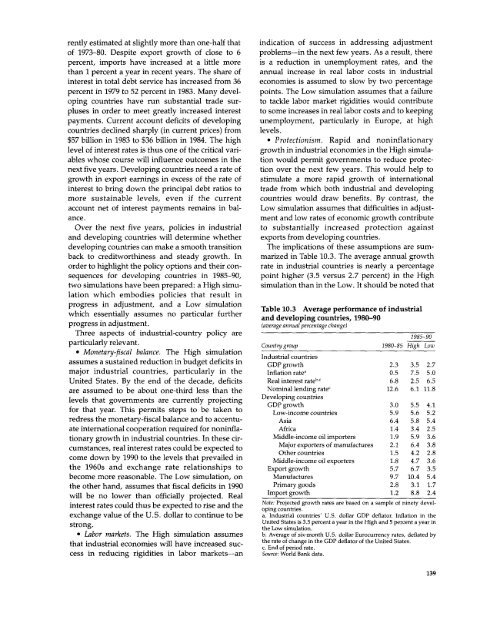World Bank Document
World Bank Document
World Bank Document
You also want an ePaper? Increase the reach of your titles
YUMPU automatically turns print PDFs into web optimized ePapers that Google loves.
ently estimated at slightly more than one-half that indication of success in addressing adjustment<br />
of 1973-80. Despite export growth of close to 6 problems-in the next few years. As a result, there<br />
percent, imports have increased at a little more is a reduction in unemployment rates, and the<br />
than 1 percent a year in recent years. The share of annual increase in real labor costs in industrial<br />
interest in total debt service has increased from 36 economies is assumed to slow by two percentage<br />
percent in 1979 to 52 percent in 1983. Many devel- points. The Low simulation assumes that a failure<br />
oping countries have run substantial trade sur- to tackle labor market rigidities would contribute<br />
pluses in order to meet greatly increased interest to some increases in real labor costs and to keeping<br />
payments. Current account deficits of developing unemployment, particularly in Europe, at high<br />
countries declined sharply (in current prices) from levels.<br />
$57 billion in 1983 to $36 billion in 1984. The high * Protectionism. Rapid and noninflationary<br />
level of interest rates is thus one of the critical vari- growth in industrial economies in the High simulaables<br />
whose course will influence outcomes in the tion would permit governments to reduce protecnext<br />
five years. Developing countries need a rate of tion over the next few years. This would help to<br />
growth in export earnings in excess of the rate of stimulate a more rapid growth of international<br />
interest to bring down the principal debt ratios to trade from which both industrial and developing<br />
more sustainable levels, even if the current countries would draw benefits. By contrast, the<br />
account net of interest payments remains in bal- Low simulation assumes that difficulties in adjustance.<br />
ment and low rates of economic growth contribute<br />
Over the next five years, policies in industrial to substantially increased protection against<br />
and developing countries will determine whether exports from developing countries.<br />
developing countries can make a smooth transition The implications of these assumptions are sumback<br />
to creditworthiness and steady growth. In marized in Table 10.3. The average annual growth<br />
order to highlight the policy options and their con- rate in industrial countries is nearly a percentage<br />
sequences for developing countries in 1985-90, point higher (3.5 versus 2.7 percent) in the High<br />
two simulations have been prepared: a High simu- simulation than in the Low. It should be noted that<br />
lation which embodies policies that result in<br />
progress in adjustment, and a Low simulation Table 10.3 Average performance of industrial<br />
which essentially assumes no particular further and developing countries, 1980-90<br />
progress in adjustment.<br />
(average annual percentage change)<br />
Three aspects of industrial-country policy are 1985-90<br />
particularly relevant. Countrygroup 1980-85 High Low<br />
* Monetary-fiscal balance. The High simulation Iountri goup<br />
sustaine reductin budgetdeficits Industrial countries<br />
assumes a sustaied reduction m budget defints m GDP growth 2.3 3.5 2.7<br />
major industrial countries, particularly in the Inflation ratea 0.5 7.5 5.0<br />
United States. By the end of the decade, deficits Real interest rateb, 6.8 2.5 6.5<br />
are assumed to be about one-third less than the Nominal lending rate' 12.6 6.1 11.8<br />
levels that governments are currently projecting Developing countries<br />
for that year. This permits steps to be taken to GDPLgrowth i59 5.65 .2<br />
redress the monetary-fiscal balance and to accentu- Asia 6.4 5.8 5.4<br />
ate international cooperation required for noninfla- Africa 1.4 3.4 2.5<br />
tionary growth in industrial countries. In these cir- Middle-income oil importers 1.9 5.9 3.6<br />
cumstances, real interest rates could be expected to Major exporters of manufactures 2.1 6.4 3.8<br />
come down by 1990 to the levels that prevailed in Other countries 1.8 4.7 326<br />
the 1960s and exchange rate relationships to Export growth 5.7 6.7 3.5<br />
become more reasonable. The Low simulation, on Manufactures 9.7 10.4 5.4<br />
the other hand, assumes that fiscal deficits in 1990 Primary goods 2.8 3.1 1.7<br />
will be no lower than officially projected. Real Import growth 1.2 8.8 2.4<br />
interest rates could thus be expected to rise and the Note: Projected growth rates are based on a sample of ninety developing<br />
countries.<br />
exchange value of the U.S. dollar to continue to be a. Industrial countries' U.S. dollar GDP deflator. Inflation in the<br />
strong.<br />
United States is 3.5 percent a year in the High and 5 percent a year in<br />
the Low simulation.<br />
* Labor markets. The High simulation assumes b. Average of six-month U.S. dollar Eurocurrency rates, deflated by<br />
that industrial economies will have increased suc- the rate of change in the GDP deflator of the United States.<br />
c. End of period rate.<br />
cess in reducing rigidities in labor markets-an Source: <strong>World</strong> <strong>Bank</strong> data.<br />
139

















